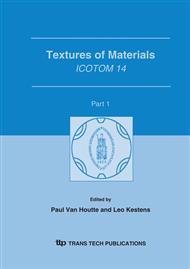p.651
p.657
p.663
p.669
p.675
p.681
p.687
p.693
p.699
Evolution of Texture in Zirconium Alloy Tubing during Processing
Abstract:
Electron backscattered diffraction (EBSD) has been used to determine microtexture in a zirconium alloy tube subject to interrupted pilgering and therefore exhibiting varying amounts of deformation as a function of axial position along the transition between the initial and final size. Texture and hardness measurements have been made as a function of the distance through the tube wall thickness and along the tube length. Texture results have been compared with co-located hardness measurements. The results show a systematic variation in the deformation texture with changes in Q (the ratio of the reduction in thickness to reduction in diameter). This is consistent with previous observations of the effect of Q on texture evolution in zirconium alloys. It is demonstrated that the texture measurements can be correlated well with the anisotropy in strength determined from hardness measurements.
Info:
Periodical:
Pages:
675-680
Citation:
Online since:
September 2005
Authors:
Keywords:
Price:
Сopyright:
© 2005 Trans Tech Publications Ltd. All Rights Reserved
Share:
Citation:


